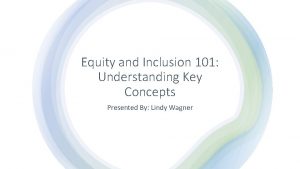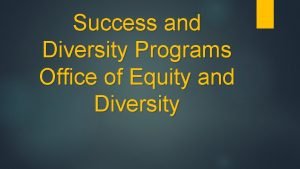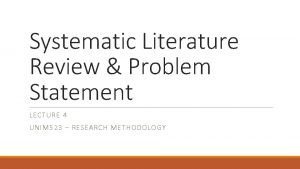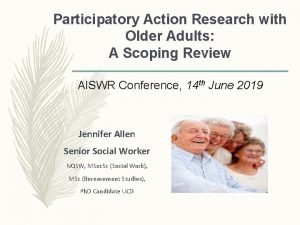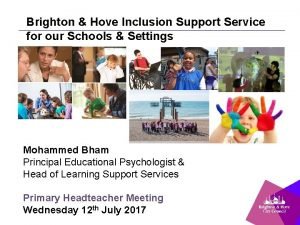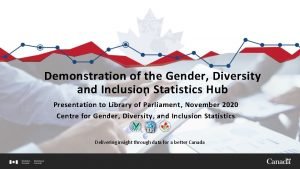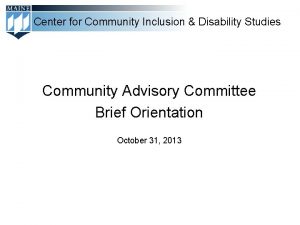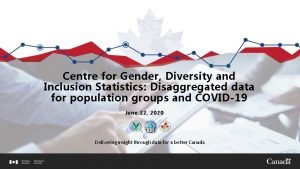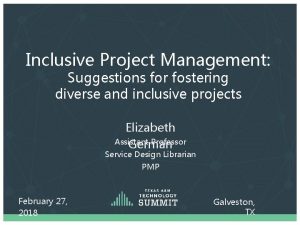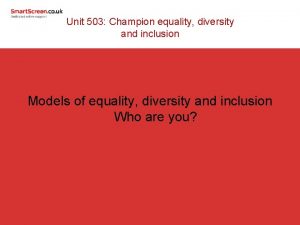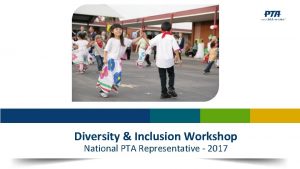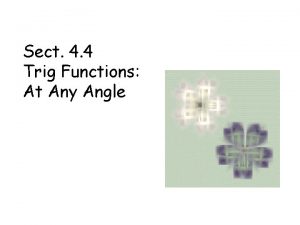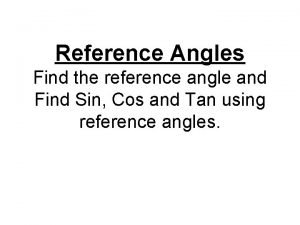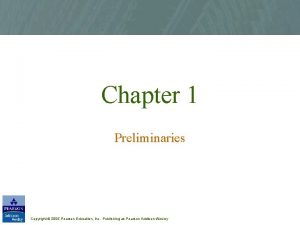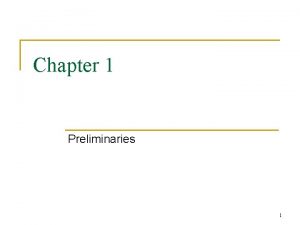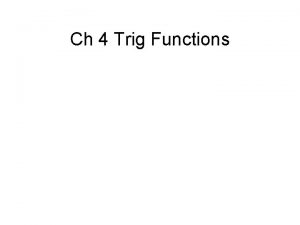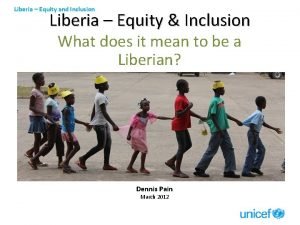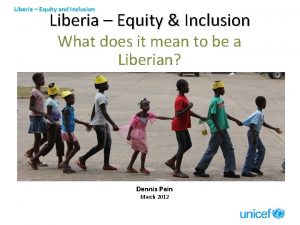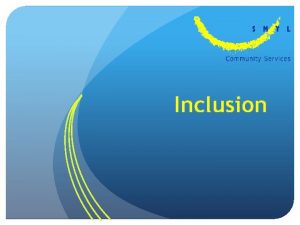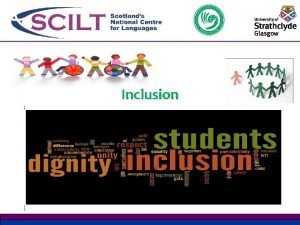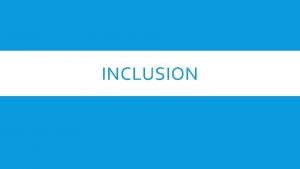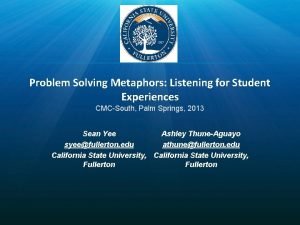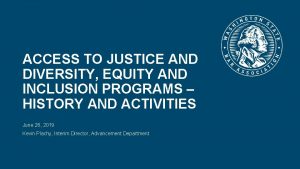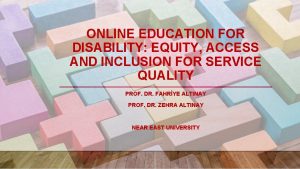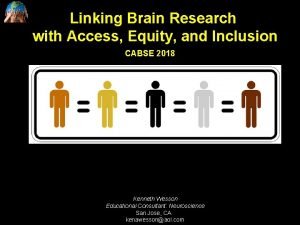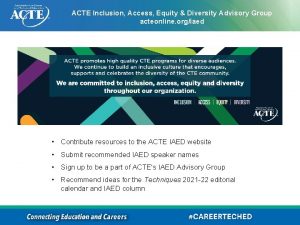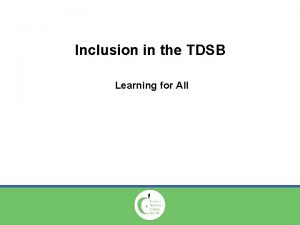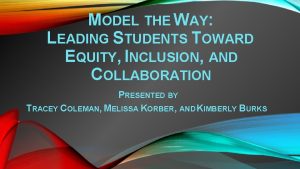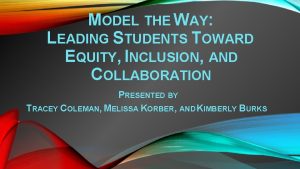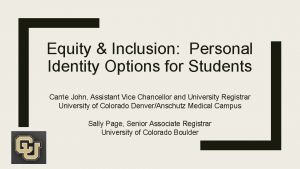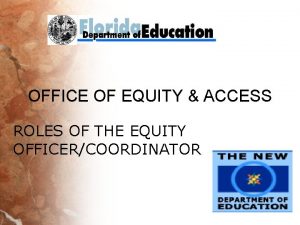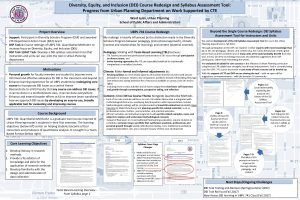Access Equity and Inclusion for all Students CMCSouth




















































































- Slides: 84

Access, Equity and Inclusion for all Students CMC-South 2018 Kenneth Wesson Educational Consultant: Neuroscience San Jose, CA kenawesson@aol. com

S. A. I. L. The environmental preconditions that should be experienced by students prior to initiating formal instruction include. . . S afety (physical and emotional) A cceptance (no “put-downs”) I nclusion, interactions and involvement (interpersonal/social aspect of memory formation) After satisfying these prerequisite neurophysiological and hierarchical conditions, students are biologically ready for L earning (students feel their immediate environment is secure enough for them to take risks, explore and discover). Source: Kenneth Wesson (2011). Education for the Real World; Six great ideas for parents and educators. Brain World, Issue 2, Volume II Winter 2011.

Abandoning Our Cognitive Frames The illiterates of the future are not those who cannot read or write, but those who cannot learn, un-learn, and re-learn. --Alvin Toffler

What Mathematics Teachers Had To Do for HS Students a Generation Ago 1. Prepare the college-bound for calculus. 2. Prepare the non-college-bound for careers. 3. Identify which students were which (and teach them accordingly).

What Teachers Must Do for All K-12 Students Today 1. 2. 3. 4. Prepare them all for calculus. Prepare them all for careers. Prepare them all for a life dominated by technology. Prepare them all to pass the state-mandated competency tests. 5. Prepare them all to meet the CCSS ELA standards, the CCSS Math standards, and the NGSS standards

Access and Equity for all Students, Including… • What role do (a) teachers’ attitudes, (b) our students’ emotions, and (c) active learning experiences play in learning, memory and student achievement? • How do I get my students’ attention and keep them engaged in order to learn mathematics more deeply? • “How do I make certain that every classroom practitioner in my building becomes an unforgettable teacher? ” Interactions, quick writes and quick talks

Access and Equity for all Students “Learning is a fundamental human need; education is a basic human right that we must extend to every child. " -- Daniel Schwarz, Stanford University “What formal education for one child for one year depends on what his/her teacher believes, knows, and does – and doesn't believe, doesn't know, and doesn’t do".

Knowing Your Students • Knowing who you teach (a child with 100 B neurons capable of making an infinite number of learning connections for a lifetime) is just as important as what you teach - disciplinary content. • “I teach algebra. ” No, you teach students whose brains prefer to learn by actively making elaborate connections inside their brains.

When it Comes to Learning Only the Gray Matters § Our students come in a variety of colors, but all brains are basically gray. It is only the gray matter that truly matters in learning and memory. § Boosting achievement and maximizing student potential hinges on educators developing a robust knowledge reservoir for teaching with only the color of the brain in mind.

Abandoning Our Cognitive Frames and Changing the Narrative Our best instructional efforts require a shift from… “What am I supposed to teach? ” to “How do my students learn? ”

Diversity, Equity, and Access Diversity recognizes the myriad ways in which individuals are unique and different from one another Equity denotes that all individuals should be treated fairly both because of and in spite of their differences Access means that each diverse individual can take advantage of all of the resources available, and that there are no restrictions on opportunity (the achievement gap = “opportunity gap”)

Cognitive Science Children/students (young brains)… • learn at different rates • grow at different rates • learn in different ways • reach competence in skills more effectively through different strategies/means • learn some content information more slowly, and other types of information/skills quicker and more deeply (with different strengths and capabilities) • Cannot teach all students at the same pace in the same way

Mindsets: The Impact of + Expectations • Researchers administered the Stanford-Binet Intelligence Scale-V to (30+) 1 st grade students at the beginning of the school year. “The test results indicate that 5 students scored at or above the genius level (140). ” → Confidentiality agreement: Teacher could not share the test results. • Monitored the behavior of teacher & students • At the end of the academic year, the students were re -tested to determine if there was any variance from the first set of IQ scores. • Q: Guess how many scored at the genius level on the second administration of the test? Who? Why?

Mindsets: The Impact of + Expectations • A: The same 5 students. • However, their scores on the 1 st test were not even close to the best scores – only slightly ↑ average. • The quality of her teaching, her treatment, and her expectations ↑ the test scores of the 5 targets • Her efforts to “keep” them at the ↑ performance level, “elevated” them to ↑ level in the classroom. * The results we get from students, often reflect what we expected from those students and how we nurtured them (causal effect) to achieve.

The Dark Side of Negative Expectations There is an unseen implicit curriculum (like “smog in the air” – no formal coursework needed) that our “different” students “feel” from the treatment that they (and people like them) receive everyday. It is often more powerful than the explicit curriculum.

The Dark Side of Negative Expectations Whose culture is admirable? Who is intelligent? Who is “normal”? Who is “a problem”? Who is “deficient”? What constitutes beauty? Whose customs are strange? Whose language is “standard”? Who decides? Who will benefit? Who will lose? What are the consequences for each/all?

Schemas: Non-conscious Hypotheses • Schemas: “mental files” (expectations/stereotypes) that shape our perceptions and expectations of other groups as well as ourselves. • All schemas influence each group members’ judgement of others and how he/she will be judged based on these stereotypes (what is going on inside the minds of others. )

Racial Disparities in Use of Suspension for 1 st Time Offenders Percent of first time offenders cited for committing the offense who received an out of school suspension as punishment 50% 45% 33% 35% 30% 24% 25% 20% 15% 40% 38% 40% 43% 15% 17% 15% 10% 5% 0% Cell Phone Dress Code White Source: Losen, 2012 Disruptive Black Display of Affection

Internalization → The “Self-fulfilling Prophecy” Stereotype Threat What is stereotype threat? Stereotype threat is the feeling of being at risk of confirming a negative stereotype about a group to which you belong. Ø Stereotype threat almost invariably leads to underperformance Ø Stereotype causes a belief that one is being judged unfairly Ø Everyone subscribes (consciously and unconsciously) to stereotypes. Heuristics – the mental shortcuts of daily living and behavior. (90 -95%) Ø Everyone can be a victim of stereotype threat (affects our subsequent behavior as well as thought-processing → in the same manner as any “fear” response) Stereotype threat is associated with activations in amygdala and the frontal lobes → “emotional hijacking” Stereotyping is associated with activations in hippocampus, amygdala and the frontal lobes L R

Stereotype Threat • Black American students perform worse than white American students on tests when they think that the tests are measuring their natural abilities. • When black students are told that a test is not measuring their abilities (esp. , natural abilities) they perform just as well as white students. • Black athletes did worse than white athletes when they were led to believe that a game of miniature golf was assessing their “sport strategic intelligence. ” • When the test was framed as a measure of “natural athletic ability” the white athletes did worse than black athletes.

Stereotype Threat Our ability worsens when we are reminded of a negative stereotype about one of the groups we belong to. Psychologists studying mathematical ability found: • Women perform worse on math tests when they think the test will produce gender differences. • White men perform worse on math tests when they think they are competing only with Asians.

Emotions Can Become a Catalyst or an Obstacle to Learning Afraid to fail (“performance Avoidance”) “Failure is not an Option” Failure is nearly always a prerequisite for future learning, success in learning. Most initial learning and discoveries occur via trial-anderror strategies.

Mindset and Accomplishments What else might you have been able to achieve in life, if you had not been afraid to try? Based on your answer, what important message should you communicate to your students?

Access and Equity Targeted groups (“High-need” – Different needs) Non-standard English Learners Ethnically Diverse Learners Foster Youth Girls and Young Women (Gender Equity) Advanced Learners and Gifted Learners Students with Disabilities Students Experiencing Difficulties with Literacy in Science and Engineering Students Living in Poverty (the single common thread)

↑ Discrimination + ↓ Education = Poverty → illiteracy → poor employment opportunities → low-paying jobs → more poverty and economic vulnerability → restricted to living in virtually uninhabitable slums → a seemingly endless cycle of cascading deleterious consequences

Poverty, Environment, and Brain Development Factors contributing to cognitive deficits, as well as mild to profound brain damage include the following: • inadequate prenatal care • poor perinatal nutrition • smoking during pregnancy • second-hand smoke • lead poisoning from lead pipes and lead-based paints • premature births • babies with low birth weights “Health disparities” with ↑ predictable consequences • prenatal substance exposure (recreational drugs)

Access and Equity: Achievement Gap or an “Opportunity Gap” Disparities in course offerings mean students of color have fewer opportunities to challenge themselves with more difficult courses -- math, science, and STEM. Fewer black students have access to a full range of HS math and science courses – algebra I, geometry, algebra II, calculus, biology, chemistry and physics (as well as AP classes and AP prep).

A ↑ %age of Teachers with 15+ years Experience = $3 M more in Salaries: “Return on Investment” Very few Honors AP IB Courses (STEM) SAT College admissions

Poverty and Brain Developmental neurobiology, early brain development (zero-three), and the impact of negative environmental circumstances on brain development (particularly prenatal, postnatal, infant, toddler, and preadolescence) can influence learning capabilities.

IQ and “Achievement” Testing? Kenneth Wesson, a founding member of the Association of Black Psychologists wrote brilliantly, “Let’s be honest. If inner-city children consistently outscored children from wealthy suburban homes on standardized tests, is anyone naïve enough to believe that we would still insist on using these tests as indicators of success? ” “The Big Picture” by Dennis Littky

If they don't learn the way you teach, then why not teach the way they learn?

Experience Shapes the Brain The brain is the only human organ that depends on experience to determine its development (how, where, when, and if it develops and when development is arrested. ) Author Joseph Epstein said, "We are what we read. " Neuroscientists would modify that statement to say that “We are what we experience. ”

20+ Years of Research in Cognitive Science: High Impact Learning Strategies 346 pages 1. People learn and remember best through realworld first-hand experiences, not through memorization. 2. Children are born investigators. 3. We attempt to “make sense” of all incoming stimuli through the senses, visualization, and through numbers and language.

Phenomenon-based Learning (Experience-based Learning) Pheno-BL is grounded in research indicating that learning is enhanced when students (1) are motivated by curiosity (2) get physically involved (3) receive ongoing feedback from the activity itself (not from the teacher, and not from the test).

“I have a discipline problem in my classroom. ” No! You have an engagement problem… Experience: Active and engaged students, … Ø 1. Are less likely to disrupt Ø 2. Earn higher grades Ø 3. Feel more confident about learning to learn Ø 4. Are willing to accept more challenges Ø 5. Retain information longer Ø 6. Are far more likely to become life-long learners (Brewster, 2000)

How well do we teach creativity, visualization, and innovative thinking? The Power of Visualization Seeing With the Mind’s Eye

2 3 8 12 Closest to a) ½ b) 2 c) 10 d) 15 Symbolic imaging for the young learner is far more difficult than object imaging.

VST = another way of “knowing” 2 3 8 12 Closest to a) ½ b) 2 c) 10 d) 15 One must have a picture in mind before it can be connected to a symbol.

Mathematics is…The study of patterns and relationships …fractions, decimals, percent, and fractional parts of a circle, all represent the same part of a whole

“How does the human brain learn math? ”

Mathematics is… • The study of patterns and relationships among quantities, numbers, and shapes. (Not surprisingly, patterns is listed as the 1 st of the 7 CCC’s in the NGSS). While science helps us understand the natural world around us, mathematics helps make quantitative sense of that natural world (mathematizing the phenomenon under study), as we examine it applying the concepts of mass, distance, volume, size, etc. , in a given focus (like engineering) as we p-s in that natural world.



Fibonacci Numbers and Nature 0 1 1 2 3 5 8 13 21 34 55 89 144 233 377 610 987 lilies and iris buttercup, wild rose, larkspur delphiniums ragwort, corn marigold, cineraria, poppy seed head aster, black-eyed susan, chicory daisies, plantain, pyrethrum michaelmas daisies, the asteraceae family sunflowers

Your hand to forearm is also 1. 618 (the “Golden Ratio”).

Each section of your index finger, from the tip to the base of the wrist, is larger than the preceding one by about the Fibonacci ratio of 1. 618 (and is 0. 618 as large) , also fitting the Fibonacci numbers 2, 3, 5 and 8. By this scale, your fingernail is 1 unit in length. Curiously enough, you also have 2 hands, each with 5 digits, and your 8 fingers are each comprised of 3 sections. All Fibonacci numbers.

Math and the Biological Brain

Math with the Brain in Mind § Even animals (mammals) and infants show signs of an innate brain mechanism, the “accumulator, ” that interprets numbers as approximate quantities and makes quantitative (semi-numerical) comparisons. § A band of 5 chimpanzees will never attack a group of six. They are capable of making the 1 -to-1 correspondence between members of two collections and determine which of the two collections is larger (i. e. , has the physical advantage). §There is “domain specificity” in the brain that plays a role in the neural representations for numbers and quantities. § The left inferior parietal lobe (more specifically the “angular gyrus” located in the plurimodal association cortex) is a key site for “number sense. ”

Math with the Brain in Mind

Mathematical Operations and their Corresponding Brain Regions Math skill Brain Region Code Addition facts Perisylvian region of the left hemisphere Verbal Multiplication facts Perisylvian region of the left hemisphere Verbal Subtraction Bilateral occipital-temporal regions Visual/verbal Number recognition Fusiform gyrus Visual/verbal Estimation skills Bilateral inferior parietal regions Magnitude Fractions Bilateral inferior parietal regions Magnitude Division Bilateral inferior parietal regions Magnitude

Math with the Brain in Mind Neural Network Similarities for Reading and Mathematics Brain Region Reading function Math function 1. Inferior Frontal gyrus Breaks down larger words into smaller phonological units Breaks down larger numbers into smaller more assessable units 2. Angular gyrus Visual-spatial appreciation of fixed symbols including words (left hemisphere) Automatic recognition of letters and words Visual-spatial recognition of mathematical facts and symbols 3. Occipital-temporal regions Automatic recognition of numbers and digits

School Readiness and Later Achievement Using 6 longitudinal data sets, the authors investigated the links between three key elements of school readiness—schoolentry academic attention, and socio-emotional skills—and a child’s school reading and math achievement later in school. Across all 6 studies, the strongest predictors of later academic achievement are school-entry math, reading, and attention skills. A meta-analysis of the results shows that 1. early math skills have the #1 greatest predictive power 2. early reading skills were the 2 nd best predictor 3. attention skills were 3 rd best in predicting later school success. Duncan, et. al Developmental Psychology (2007) American Psychological Association

What Does the Brain Do All Day? Our brain serves us best when it is. (1) predicting the future, (2) anticipating the consequences of action – its own actions or that of others, (3) saving us time. It uses patterns and experience to help us create internal models of the world, in ways that allow us to survive.

PERC 3 S There are five BC elements that the human brain seeks while processing incoming stimuli for personal “meaning, ” which makes the information “memorable” and worth remembering. (1) Patterns (derivative of visual experience) (2) Emotions (3) Relevance (4) Context, Content, and Cognitively-appropriate (5) Sense-making → Stories (narrative) The brain examines all learning experiences through the lens of PERCS → determines how much we remember, how long we remember it, and whether or not we understand it enough for subsequent application (transfer of knowledge)

X + Y = 2 X + 2 Y = 3 X + 4 Y = 5 X + 3 Y = 4 X + Y = 3 Y + 4 X =

Caps and Umbrellas Caps = X Umbrellas = Y X + 2 Y = 80 2 X + Y = 76

Caps and Umbrellas 5 4 3 Number of Umbrellas (Y) 2 80 1 76 0 0 1 2 3 Number of Caps (X) 4 5

Caps and Umbrellas Number of umbrellas 5 140 164 188 212 236 260 4 112 136 160 184 208 232 3 84 108 132 156 180 204 2 56 80 104 128 152 176 1 28 52 76 100 124 148 0 0 24 48 72 96 120 0 1 2 3 4 5 Number of caps

Caps and Umbrellas X + Y = 52 2 X + 2 Y = 104 3 X + 4 Y = 184 5 X + 3 Y = 204 4 X + Y = 124 3 Y + 4 X = 180

Mathematical Fluency (Russell 1999) Mathematical fluency 1. Efficiency – uses strategies and procedures that appropriate to the mathematical situation and stays on track (working memory) 2. Accuracy – applies number facts with precision and understands their relationships (automatic retrieval) 3. Flexibility – knows multiple ways to solve a problem and knows how to double-check his/her work and results (a deep and robust “cognitive tool chest”)

1. = $80 = $76 Double the 2 nd equation } = (2 X $76) $152

1. = $80 Subtract the 1 st equation from the doubled 2 nd equation… } = $152

1. = $80 Eliminate the like properties from the two equations } = 152 -80 72

Leaves… 1. = $72 3 (caps) = $24 (1 cap)

PERC 3 S There are five BC elements that the human brain seeks while processing incoming stimuli for personal “meaning, ” which makes the information “memorable” and worth remembering. (1) Patterns (derivative of visual experience) (2) Emotions (3) Relevance (4) Context, Content, and Cognitively-appropriate (5) Sense-making → Stories (narrative) The brain examines all learning experiences through the lens of PERCS → determines how much we remember, how long we remember it, and whether or not we understand it enough for subsequent application (transfer of knowledge)

Emotions, Attention and the Brain • Emotions → attention → learning → memory (integrated in the brain) • It is neurologically impossible to learn and remember information to which the brain has not paid attention. Illocutionary intent - what a speaker means to say, although the sentence itself may not be perfectly consistent with the intentions: “The garbage is beginning to smell, ” which means, “Take that garbage out!” – Close attention to the words does not aid in understanding the intended message.

June 2018 Saber-toothed Tigers and stressed-out students: an examination of the neuroscience behind safe, secure learning environments – K. Wesson “There is a growing body of neurological evidence supporting the notion that if students do not feel safe, secure and comfortable in a learning environment, their ability to learn is severely compromised, regardless of the quality of instruction or the level of instructional expertise demonstrated by the classroom practitioner. ” Safety is a learning requirement Maslow’s Hierarc hy of Needs

The Neuroscience Behind Safe, Secure Learning Environments To a learning brain, new curricula, the latest i-Pad, and the best-trained teacher will not offset the absence of physical and emotional safety. “…stressed-out brains (in students or adults) are physically incapable of establishing and maintaining the requisite neural connections inside the brain that are necessary to support content-related learning as well as long-term memory formation. ” Safety is an Equity Issue

PERC 3 S There are five BC elements that the human brain seeks while processing incoming stimuli for personal “meaning, ” which makes the information “memorable” and worth remembering. (1) Patterns (derivative of visual experience) (2) Emotions (3) Relevance (4) Context, Content, and Cognitively-appropriate (5) Sense-making → Stories (narrative) The brain examines all learning experiences through the lens of PERCS → determines how much we remember, how long we remember it, and whether or not we understand it enough for subsequent application (transfer of knowledge)

Time is often taught as a random abstract concept “What time is it? ”

Social Studies/History: “Shadow Clocks” • Obelisks (slender, tapering, four-sided monuments) moving shadows on a sundial permitted people to partition the day into morning and afternoon. • Later, additional markers placed around the base of an obelisk further subdivisions of time (hours).

Measure and Insert Data Points (Graph) of Changes in the Position of the Sun Throughout the Day: Data from your own “obelisk”

Making connections

Time is most effectively taught in a Science context, not as a Math skill Time reflects the regular degrees of consistent changes in the earth-sun relationship. We calibrate those degrees of change in “seconds, minutes, hours, days, etc. , ”-- applying math to the science content.

PERC 3 S There are five BC elements that the human brain seeks while processing incoming stimuli for personal “meaning, ” which makes the information “memorable” and worth remembering. (1) Patterns (derivative of visual experience) (2) Emotions (3) Relevance (4) Context, Content, and Cognitively-appropriate (5) Sense-making → Stories (narrative) The brain examines all learning experiences through the lens of PERCS → determines how much we remember, how long we remember it, and whether or not we understand it enough for subsequent application (transfer of knowledge)

Schools vs. the Real-world (“Interdisciplinarity is like real life”) “…school learning is abstract, theoretical and organized by disciplines, while work in the real world is concrete, specific to the task, and organized by problems/projects…” not by disciplines. -- Organisation for Economic Co-operation and Development (OECD), “Learning for Jobs” (2009)

Which Endeavor Involves Math or Science? Solving problems Providing water New EGadgets Creating New cars Fashion & beauty Sports Food (non-food ) Health & medicine Built environm ent

You will be planning, designing, and making each of the objects, structures or products listed below. Which of them require the skills that are developed in the STEM/STREAM subjects? Science Technology Reading (ELA) Engineering Art/ Design Math Running shoes ● ● ● Skateboard park ● ● ● Non-tipping Kayak ● ● ● Backpack ● ● ● New i-Pod ● ● ● Amusement park rides ● ● ● Racing bike ● ● ● Sunglasses ● ● ● Electronic game ● ● ● Object

PERC 3 S There are five BC elements that the human brain seeks while processing incoming stimuli for personal “meaning, ” which makes the information “memorable” and worth remembering. (1) Patterns (derivative of visual experience) (2) Emotions (3) Relevance (4) Context, Content, and Cognitively-appropriate (5) Sense-making → Stories (narrative) The brain examines all learning experiences through the lens of PERCS → determines how much we remember, how long we remember it, and whether or not we understand it enough for subsequent application (transfer of knowledge)

Math Fact Families: Drawing does for the brain during the day, what dreaming does for the brain at night.

How Do Children Learn Best? 1. Give them something to do? 2. Give them something to think about? 3. Give them something to talk about? (BBK) 4. Whenever possible, have young students first draw what they will later write about (using the pictures in the “mind’s eye”) 5. After students do, think, talk about and draw the target concept (experience it), then we can say that they “know” it.

“Reflect and Connect” “We don’t learn from experience, we learn by reflecting on it. ” -- John Dewey • What was the most valuable idea that you learned from this morning? • Please write down 2 “I will statements”: How will you use the information shared today, when you return to your school or school district?

Contact Information: Kenneth Wesson Educational Consultant: Neuroscience (408) 323 -1498 (office) (408) 826 -9595 (cell) San Jose, CA Ken. wesson@schoolspecialty. com sciencemaster. com

 Diversity equity and inclusion 101
Diversity equity and inclusion 101 Etsu equity and inclusion conference
Etsu equity and inclusion conference Name a line containing point a
Name a line containing point a Rizal carved the image of the virgin mary
Rizal carved the image of the virgin mary Terminal access controller access control system plus
Terminal access controller access control system plus Terminal access controller access-control system
Terminal access controller access-control system Literature review problem statement example
Literature review problem statement example What is inclusion and exclusion
What is inclusion and exclusion What is the inclusion and exclusion criteria in research
What is the inclusion and exclusion criteria in research California map to inclusion and belonging
California map to inclusion and belonging Diversity and inclusion scorecard
Diversity and inclusion scorecard Bhiss
Bhiss Centre for gender diversity and inclusion statistics
Centre for gender diversity and inclusion statistics Center for community inclusion and disability studies
Center for community inclusion and disability studies Diversity and inclusion consulting
Diversity and inclusion consulting Centre for gender diversity and inclusion statistics
Centre for gender diversity and inclusion statistics Korn ferry d&i maturity model
Korn ferry d&i maturity model Diversity and inclusion training objectives
Diversity and inclusion training objectives Dei pulse survey
Dei pulse survey Stevenson and black 2007 inclusion spectrum
Stevenson and black 2007 inclusion spectrum Hse diversity equality and inclusion strategy
Hse diversity equality and inclusion strategy Mona talent priority
Mona talent priority Champion equality diversity and inclusion
Champion equality diversity and inclusion Pta diversity and inclusion
Pta diversity and inclusion What trig functions are positive in quadrant 2
What trig functions are positive in quadrant 2 All students take calculus
All students take calculus Refernece angle
Refernece angle Pearson education
Pearson education Trigo
Trigo All students take calculus
All students take calculus All students take calculus
All students take calculus The dignity for all students act
The dignity for all students act Kontinuitetshantering i praktiken
Kontinuitetshantering i praktiken Novell typiska drag
Novell typiska drag Tack för att ni lyssnade bild
Tack för att ni lyssnade bild Vad står k.r.å.k.a.n för
Vad står k.r.å.k.a.n för Varför kallas perioden 1918-1939 för mellankrigstiden?
Varför kallas perioden 1918-1939 för mellankrigstiden? En lathund för arbete med kontinuitetshantering
En lathund för arbete med kontinuitetshantering Personalliggare bygg undantag
Personalliggare bygg undantag Personlig tidbok fylla i
Personlig tidbok fylla i Anatomi organ reproduksi
Anatomi organ reproduksi Vad är densitet
Vad är densitet Datorkunskap för nybörjare
Datorkunskap för nybörjare Stig kerman
Stig kerman Mall debattartikel
Mall debattartikel Autokratiskt ledarskap
Autokratiskt ledarskap Nyckelkompetenser för livslångt lärande
Nyckelkompetenser för livslångt lärande Påbyggnader för flakfordon
Påbyggnader för flakfordon Kraft per area
Kraft per area Svenskt ramverk för digital samverkan
Svenskt ramverk för digital samverkan Bo bergman jag fryser om dina händer
Bo bergman jag fryser om dina händer Presentera för publik crossboss
Presentera för publik crossboss Jiddisch
Jiddisch Vem räknas som jude
Vem räknas som jude Treserva lathund
Treserva lathund Luftstrupen för medicinare
Luftstrupen för medicinare Claes martinsson
Claes martinsson Centrum för kunskap och säkerhet
Centrum för kunskap och säkerhet Programskede byggprocessen
Programskede byggprocessen Mat för unga idrottare
Mat för unga idrottare Verktyg för automatisering av utbetalningar
Verktyg för automatisering av utbetalningar Rutin för avvikelsehantering
Rutin för avvikelsehantering Smärtskolan kunskap för livet
Smärtskolan kunskap för livet Ministerstyre för och nackdelar
Ministerstyre för och nackdelar Tack för att ni har lyssnat
Tack för att ni har lyssnat Vad är referatmarkeringar
Vad är referatmarkeringar Redogör för vad psykologi är
Redogör för vad psykologi är Matematisk modellering eksempel
Matematisk modellering eksempel Tack för att ni har lyssnat
Tack för att ni har lyssnat Borra hål för knoppar
Borra hål för knoppar Orubbliga rättigheter
Orubbliga rättigheter Stickprovsvarians
Stickprovsvarians Tack för att ni har lyssnat
Tack för att ni har lyssnat Steg för steg rita
Steg för steg rita Verksamhetsanalys exempel
Verksamhetsanalys exempel Tobinskatten för och nackdelar
Tobinskatten för och nackdelar Toppslätskivling effekt
Toppslätskivling effekt Datumr
Datumr Egg för emanuel
Egg för emanuel Elektronik för barn
Elektronik för barn Antika plagg
Antika plagg Strategi för svensk viltförvaltning
Strategi för svensk viltförvaltning Kung dog 1611
Kung dog 1611 Indikation för kejsarsnitt på moderns önskan
Indikation för kejsarsnitt på moderns önskan Romarriket tidslinje
Romarriket tidslinje
